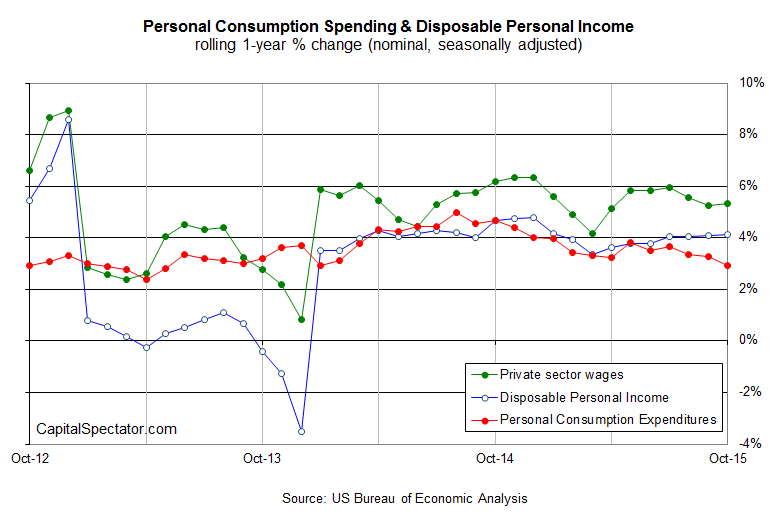Consumer spending in the US continued to rise at a snail’s pace, rising 0.1% in October, according to this morning’s release from the Bureau of Economic Analysis. That’s the second month in a row for 0.1% growth, marking the weakest two-month period for consumption in eight months.
Economists were expecting a much stronger gain—0.4% via Econoday.com’s consensus forecast. But the sluggish rise shouldn’t be terribly surprising after news from earlier this month that retail sales barely budged in October.
Perhaps the most intriguing part of today’s report is that the weak rate of consumption is self imposed. Disposable personal income rose a strong 0.4% last month and the annual growth rate inched higher for the fourth month in a row.
It’s anyone’s guess if the expanding divergence between rising income and decelerating consumption growth will roll on. Meantime, it’s clear that the reluctance to spend isn’t due to stumbling income. Disposable personal income (DPI) increased 4.1% for the year through October, fractionally higher than the previous month’s rise. As a result, DPI is advancing at the strongest year-over-year rate in nine months.

The relative strength in income is especially conspicuous via the trend in private-sector wages, which ticked up to a 5.3% annual pace last month (green line in chart above). That’s a middling rate relative to the range over the last several years, but recent data suggests that wage growth is stable. That’s more than you can say for consumption, which continues to slide in year-over-year terms (red line).
For the moment, there are more questions than answers regarding the hesitancy to spend. Is this an effort to ramp up savings ahead of the holiday shopping season? Or is the recent data a sign that conspicuous consumption is losing favor with the American consumer?
Whatever the answer, there’s no doubt that the preference for saving is back in vogue. The share of DPI that was banked last month increased to 5.6% last—the highest rate in nearly three years.







